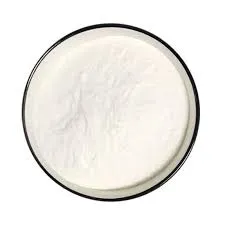
אוק . 21, 2024 05:26 Back to list
Understanding the Applications and Benefits of HPMC in Various Industries
What is HPMC Used For?
Hydroxypropyl methylcellulose (HPMC) is a versatile, semi-synthetic polymer derived from cellulose, a naturally occurring organic polymer found in the cell walls of plants. Its unique properties make it a valuable ingredient in various industries, including pharmaceuticals, food, cosmetics, and construction. Understanding the applications of HPMC can provide insights into its significance and benefits in these fields.
Pharmaceutical Applications
One of the primary uses of HPMC is in the pharmaceutical industry. It acts as a binder, film-former, and controlled-release agent in drug formulations. Its ability to form gels when mixed with water makes it ideal for use in tablets, capsules, and other dosage forms. By controlling the release rate of active ingredients, HPMC enhances the effectiveness of medications, ensuring that they dissolve and are absorbed by the body at the desired rate. Additionally, HPMC is utilized in ophthalmic solutions, providing viscosity and stability, which help improve the comfort and effectiveness of eye drops.
Food Industry
HPMC is widely used in the food industry as a thickening agent, emulsifier, and stabilizer. Its ability to retain moisture makes it valuable in various food applications, especially in baked goods, sauces, and dressings. By improving the texture and texture perceptions, HPMC contributes to the overall quality of food products. Moreover, it is often used in gluten-free and low-fat food formulations, helping to mimic the texture and structure that gluten provides in traditional products. Its use in the food industry is generally regarded as safe, making it an appealing choice for food manufacturers.
Cosmetic Applications
what is hpmc used for

In the cosmetics industry, HPMC serves as a thickening agent and a film-former in products such as creams, lotions, and gels. Its non-toxic and hypoallergenic properties make it suitable for sensitive skin formulations. HPMC enhances the feel and appearance of cosmetic products, providing a smooth texture that improves the application experience. Additionally, because HPMC is a stabilizer, it helps to maintain the integrity of emulsions, ensuring that oil and water phases remain well mixed. This stability is critical for cosmetic products that have a long shelf life, providing consistent quality and performance to consumers.
Construction Industry
HPMC is utilized in the construction industry, particularly in the formulation of mortar and plaster. It acts as a water-retaining agent, improving workability and adhesion. By enhancing the performance of cement-based products, HPMC helps ensure that they cure properly, leading to stronger structures and longer-lasting finishes. Its film-forming properties also contribute to water resistance, making it a valuable additive in exterior applications. Moreover, HPMC’s use in construction can improve the reusability and recyclability of materials, aligning with the growing demand for sustainable building practices.
Other Uses
In addition to its primary applications, HPMC finds utility in various niche areas. For instance, it is used in the production of biodegradable films and packaging materials, reflecting the increasing focus on sustainability. Furthermore, HPMC has applications in the electronics industry as a component in adhesives and coatings, contributing to enhanced performance and durability.
Conclusion
Hydroxypropyl methylcellulose (HPMC) is a multifunctional polymer with diverse applications across various industries. Its unique chemical and physical properties enable it to serve as a binder, thickener, stabilizer, and film-former, making it invaluable in pharmaceuticals, food, cosmetics, and construction. As industries continue to evolve, the versatility of HPMC positions it as a critical component in meeting modern demands for performance, safety, and sustainability. Whether in a medication, a skincare product, or a construction material, HPMC demonstrates its significance by enhancing product quality and functionality, thus ensuring that it remains a relevant and essential ingredient across multiple domains.
-
Versatile Hpmc Uses in Different Industries
NewsJun.19,2025
-
Redispersible Powder's Role in Enhancing Durability of Construction Products
NewsJun.19,2025
-
Hydroxyethyl Cellulose Applications Driving Green Industrial Processes
NewsJun.19,2025
-
Exploring Different Redispersible Polymer Powder
NewsJun.19,2025
-
Choosing the Right Mortar Bonding Agent
NewsJun.19,2025
-
Applications and Significance of China Hpmc in Modern Industries
NewsJun.19,2025







